LAOS
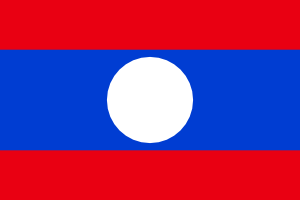
Laos, like most other southeastern Asian nations, has an interesting history that has been strongly influenced by French colonialism and later by American interventions. Their history, also like that of other southeastern Asian nations, includes tragedy inflicted on them from others. Their path to recovery has been convoluted.
Southeast Asia experienced unprecedented political and social changes in the 13th and 14th centuries. In the early 13th century, the Cambodian Khmer kingdom, under King Jayavarman VII, extended to the north and overtook Laos. However, the kingdom was overextended, and it retreated. Then the Chinese Mongol Yuan dynasty appeared to lose interest in southeast Asia, and they too retreated. This left a political vacuum which enabled formation of the first extended Lao kingdom in the mid-14th century. This kingdom was called Lan Xang (million elephants) and was based in what is today Luang Prabang. In the mid-16th century, King Setthathirat moved the capital to Viang Chan (the French later renamed the city Vientiane) in the center of the kingdom.
In the late 17th century, a succession dispute resulted in the northern area declaring its independence and dividing the kingdom in two. Then, a further dispute resulted in the southern area declaring its independence and creating a third kingdom. The resultant three kingdoms were weak and easily overcome by Siam in 1779.
Siam ruled Laos until the French took it over by gunboat diplomacy. The French ruled all of Southeast Asia east of the Mekong River. Laos, however, was not economically productive for France.
World War II weakened the French position, and the Japanese ruled Laos for six months. During that time, King Sisavang Vong was forced to declare independence from France, and Laotians formed the Lao Issara (Free Lao) – a nationalist resistance movement. When Japan surrendered at the end of the war, Lao Issara formed an interim government, and Laos was a unified country for the first time since 1779. However, King Sisavang Vong believed that Laos needed France’s protection, so he retracted his declaration of independence and dismissed the prime minister. Consequently, the National Assembly deposed the king. The French seized the opportunity and returned to power as the Lao Issara fled to Bangkok.
Two half-brothers divided the Lao Issara. Souvanna Phouma sought independence within the existing framework imposed by the French. However, Souhanouvong merged some Lao Issara with the Viet Minh and formed the Pathet Lao (Land of the Lao) whom sought to replace the colonial French with a Marxist regime. Although Souhanouvong became the public face of the resistance movement, the power lied with two others in the Indochinese Communist Party – Kaysone Phomvihane and Nouhak Phoumsavan. Weapons flowed from the Chinese through the North Vietnamese to the Pathet Lao.
France granted independence to Laos in 1953. The Pathet Lao moved to the northeast, regrouped, and began calling themselves the Lao People’s Party (LPP). Although politically independent from France, they became dependent on the North Vietnamese. Simultaneously, Souvanna Phouma became Prime Minister of the Royal Lao Government which was becoming increasingly dependent on the United States. In 1957, the half-brothers negotiated their way to a coalition government. The United States, however, believed this was an unacceptable risk of the communists rising to power, and they punitively withheld the financial aid on which the Royal Lao Government had become dependent. The coalition government collapsed after eight months.
The United States installed and supported a right-wing government without any Pathet Lao representation or the neutralism espoused by Souvanna Phouma. Civil war resumed, and a military coup was threatened. The United States supported General Phoumi Nosavan as Prime Minister, and the Pathet Lao built their forces. Guerilla warfare ensued, and Lao were killing Lao.
Captain Kong Lee seized power and demanded a return to neutrality. He appointed Souvanna Phouma as Prime Minister to maintain that neutrality. General Phoumi refused to accept this neutrality, and he began to build his opposition forces with support of the Thai military and cash and weapons supplied by the United States’ CIA. When these opposition forces marched on Vientiane, Kong Lee withdrew to the Plain of Jars where his forces joined with the Pathet Lao.
A second coalition government was briefly formed in 1962, but it was doomed for failure. The Americans and North Vietnamese were providing arms and supplies to opposing factions in efforts to control the Ho Chi Minh Trail through Laos, and America’s ‘Secret War’ was underway. This war devastated Laos for twelve years.
A ceasefire in January 1973 allowed a third coalition government to form. The neutralist Souvanna Phouma was the Prime Minister, and other ministries were shared by those with political leanings both to the left and right. However, communist forces rolled through Southeast Asia, and the communist Lao People’s Revolutionary Party (LPRP) formed from remnants of the Lao People’s Party. The king abdicated, and the coalition government bowed to the inevitable.
The Lao People’s Democratic Republic (Lao PDR) formed on December 2, 1975. It greatly restricted personal freedoms such as speech and assembly. Buddhism was suppressed but not prohibited. The nation’s economy was immediately nationalized, and the US stopped all financial aid. The aid-dependent economy collapsed. Ten percent of the population fled.
The Lao economy was opened to market forces by the mid-1980s, but the government retained tight control of political power. The economy continued to improve, and they joined the Association of Southeastern Asian Nations (ASEAN) in the mid-1990s. They experienced the economic crisis of the late 1990s, but they survived.
Laos is a landlocked nation of nearly 91,500 square miles. It neighbors to the north are Myanmar and China, to the east is Vietnam, to the south is Cambodia, and to the west is Thailand. The Mekong River forms most of the western border between Laos and Thailand. Much of Laos is mountainous jungle.
The government is communist, and Lao is ruled with a tight fist. The party is stable, and political unrest is sharply suppressed. The capital is in Vientienne.
The Lao currency is the kip – LAK. The current exchange rate is approximately 85 LAK per $1 USD.
The primary industries in Laos are mining and timber. Tourism is also a growing source of national income with more than one million tourists annually. More than half of those tourists are Thai.
Laos’ population is approximately 6.5 million. This is a young population with more than 40% being less than 15 years old. Their ethnicity is almost entirely various Lao group or Hmong. Life expectancy for men is only 53.8 years, and for women it is 58 years.
The national language is Lao. Limited French or English is spoken in areas exposed to tourists. Buddhism is the primary religion with 65% of the population reporting to have Buddhist beliefs.
Education is compulsory only from age 6 to 10. Their literacy rate is 68.7%.
We crossed the Mekong River from Chiang Khong, Thailand to Huay Xai, Laos in a small longtail. The trip took only a few minutes. We spent a few days in Huay Xai, then we spent two days traveling down the Mekong River to Luang Prabang. We stayed in Luang Prabang for a week before heading down to the national capital of Vientienne where we spent only two days before crossing the Mekong River again back to Thailand.
The trip across the Mekong was fast and easy. On arrival in Huay Xai, we were able to get a visa on arrival, and we exchanged a few Thai baht for Lao kip.
Huay Xai immediately impressed us as a dirty little border town, and that image remained after spending a few days there. Our first impressions were that the town of around 15,000 was quite poor, and the people did not seem particularly friendly.
We had read that the Oudaphone Guest House was one of the better in town, so we checked in there. It was sparse and basic, but it was ok. We headed out to explore town.
As we walked, the skies opened, and it poured. We found cover and watched the local world go by as we waited it out. On returning to town, we arranged to tour the area with a local guide the following day. We had a good dinner at an Indian restaurant, and we returned to our room.
We believe that every female dog in Huay Xay was in heat that night, and every male dog was trying to make his move. We endured endless barking, yelping, squealing, etc. The dogs were still going strong in the early morning hours when the roosters started. We had not noticed that our window was directly above a large chicken coop. The roosters were still going when the children started crying. It was an ongoing onslaught of noise.
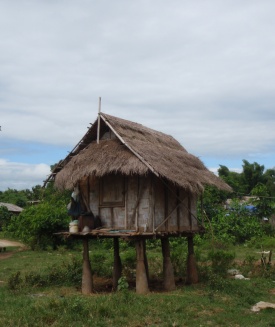
House on stilts made of 8″ artillery shells
We met our guide and headed out for a day of looking around to see what there was to see. And there was quite a lot. We climbed 108 steep steps to visit Wat Souvanakomkham. We enjoyed watching the monks go about their day and took in the beautiful view from up there. Then we walked through a Vietnamese village that had built many of its houses using 8” artillery shells as stilts. We visited Ba Nam Kok village which supports itself by distilling lao lao – a local rice liquor, and we visited Wat Sridpnakeo there. We visited a Muslim village whose name we don’t remember, but we were amused by our guide repeatedly telling us that this was a polygamous village – a seemingly upsetting issue to him. We visited Ba Nam Chang which is a quiet Hmong village. Most of its residents were out harvesting rice; however, the few women visible in the village wore the traditional Hmong clothing. We went for a bowl of noodle soup that is a mainstay of most Laotians, and we did not particularly like it. We also went to a Chinese market and a Lao market. It was a full day.
One interesting thing we noticed as we drove about was that some of the men carry rifles over their shoulders. It seemed odd to us, but supposedly it is common throughout Laos.
We were heading down the Mekong River the next day for Luang Prabang. It would be a two-day trip with an overnight stop in Pak Beng. We had hoped for a good night’s sleep, but instead it was another night of barking dogs and morning of crowing roosters. Oh well, such is life in a border town.
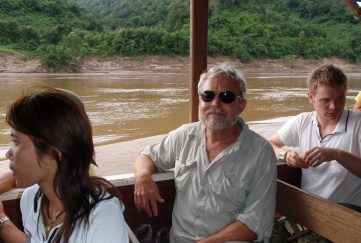
Rollin’ on the river
Our boat moved slowly, but we had 4 to 5 knots of current running with us, so we were moving along quickly. There was no industry – only light agriculture. We motored by too much trash, one dead dog, and one dead person floating in the river. We negotiated our way around some large rocks and eddys, and we made seven or eight stops along the way to pick up and drop off passengers. We had brief light rain, and we finally arrived in Pak Beng late – after dark.
Because it was dark, we took the first guesthouse we found, and it was marginally ok. We went out for a good Indian dinner, and we called it an early night (a necessity in Pak Beng where all generators are turned off at 10:00 pm). There were no barking dogs, but there were roosters in the morning.
Our boat for the next day was smaller which meant it was more crowded. There was no engine room which meant it was noisier. It. too. was late leaving. However, once we were underway, we enjoyed more dramatic scenery than the previous day. The terrain was rugged with forested mountains. We also had to negotiate more rocks and eddys than the prior day. We did not arrive in Luang Prabang until 5:30 pm. We were tired of the cramped and hard seats.
We found a nice guesthouse near town, and we walked back to the river for dinner. This was our introduction to Lao food, and we gave it mixed reviews. It rained hard for about 30 minutes, and then it cleared. We slept like babies without barking dogs or crowing roosters.
Our guesthouse had only six rooms, and they had reservations for all rooms the next night, so we had to move after enjoying a nice and leisurely breakfast. We moved only a short distance down the street to a place we really enjoyed – Villa Champa.
We walked around town and found it quite charming. It lacked the ‘border town’ feeling that we did not like in Huay Xai. We went to an Indian restaurant for lunch and discovered it was related to the restaurant where we had eaten in Pak Beng two nights before. It was a good lunch. But we saw Luang Prabang come alive after dark when we went to the night market.
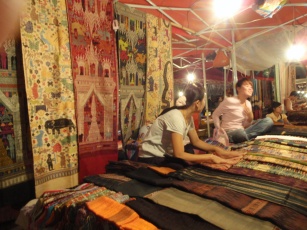
Textiles at Luang Prabang’s night market
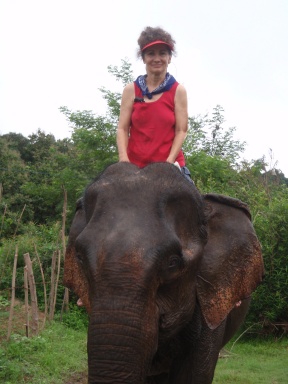
Nita with an ear-to-ear grin
We were amazed at the textiles! The night market stretches about a half mile, and it is lined with textiles on both sides of the street. In some places, there are also back-to-back stalls set up in the middle of the street making them four deep. There are silks and cottons and hand-worked projects. It was overwhelming. We decided that we needed to just take it in this first night, so we bought nothing. Nita was in heaven.
The next day we went to a shop/gallery in town named Ock Pop Tok which means East meets West. This is the retail outlet for their specialty textiles – many which were made at their weaving center a few miles out of town. We hired a tuk-tuk and headed out to the weaving center. Through a quirk of luck, we were the only visitors at the center, and we got a lengthy private tour. It was fabulous! We learned much more about silks than we had in China, and we especially enjoyed learning about natural dyes.
After leaving the weaving center, we roamed around the Phousy Market. It was not particularly exciting, but it was very local, so we got to see a slice of local life. But now Nita was ready to return to the night market in town and buy, buy, buy. So much for the restraint she had shown in northern Thailand.
Most of what we bought at the night market was gifts for others, but a few pieces of fabric did make their way in to our bag. Then we had street food for dinner, and it was delicious – grilled chicken with lime and chili, sticky rice, and green papaya salad. We were really enjoying Luang Prabang.
The next day was devoted to chores. We also made arrangements to spend a few days at an elephant park – something we have wanted to do since heading north in Thailand. There are numerous businesses that will take you out of town and provide a ride on an elephant. We wanted more. We wanted to spend time with the elephants and learn a bit about them. We chose to go with Tiger Trail. Tiger Trail (www.laos–adventures.com) is an eco-tourism group that runs the Elephant Park Project. The Elephant Park, less than ten miles out of Luang Prabang, provides homes for elephants that have been rescued from the logging industry. Money raised from various eco-tourism activities supports the elephants and their mahouts (handlers). The Elephant Park hires all local employees, and much of their income is returned to the local villages.
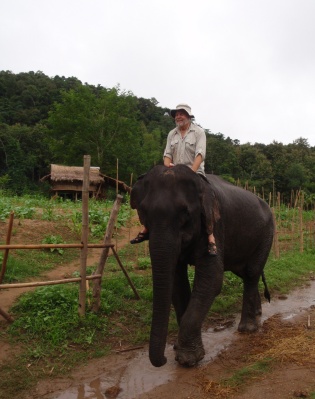
Bud enjoying the ride
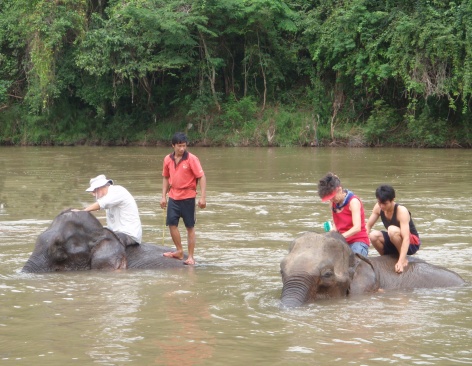
Bathing the elephants – a truly memorable experience
We spent two days with Tiger Trail. Part of both days was spent with the elephants, and we also visited Tad Se waterfall and kayaked down the Khan River. Our guide was Pon.
Our first day with the elephants was learning a bit about them and getting to know them. Although Laos is often described as “the land of a million elephants”, in actuality, only about 2,000 Asian elephants remain. They weigh from 3.5 to 5 tons. They eat more than 400 pounds and drink more than 50 gallons daily. They sleep less than 1 hour per day.
We first rode the elephants in a chair to adapt to their movement. Then we rode them sitting on their neck – a very different motion from any other animal either of has ever ridden. We rode up and down hills through a teak forest and down a shallow part of the river. We then took them part way up the mountain to where they spend the night. They were given the command to kneel, and we got off. The mahouts took them the rest of the way up. By this point we’re highly charmed by these gentle giants.
We took a boat across the river to check in to the lodge for the night. Given where we were, we had basic expectations, but this place was beautiful. It is built of teak, and it has huge rooms with breathtaking views. A nice surprise.
We then took a small boat upriver to Tat Se Waterfall – another breathtaking sight. This is a natural limestone formation with crystal clear turquoise pools below a wandering path through the trees. Bud went swimming in the largest pool.
We returned to the lodge for a very good dinner and slept well without dogs or roosters.
We got up early to go up the hill and get our elephants. The mahouts had brought them part of the way down so we did not have to do any extensive hiking before coffee. We took the elephants to the river and bathed them. We rode them in to the river until they were shoulder deep, and we started working them over with a scrub brush. We loved it, and so did the elephants. We could feel them relax, and we watched them blow bubbles with their trunks. We were both glad that neither of our elephants showered us with their trunks. They probably have learned that their baths get cut short when they do that. We were as wet as our elephants, and we rode them back to the main camp. We spent a little time with them, and it was already time to say goodbye. Neither of us was ready to leave. We could have stayed for a week or two.
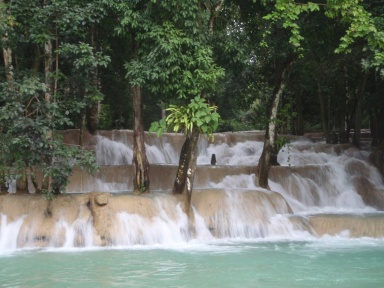
Tat Sae waterfall
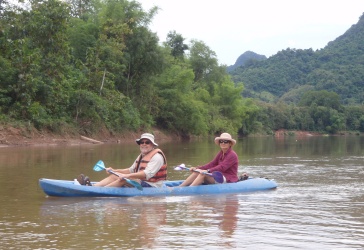
Kayaking on the Khan River
But the day was still young, so we returned to the lodge for a late breakfast. Then we went kayaking down the Khan River. We shared a double kayak, and it became a comedy of errors. We had a leaky kayak that lacked a plug in its stern, so we spent a lot of time stopping to drain our flooded kayak. We had to negotiate a few mild rapids, and we only courted disaster on one of them. A truck met us a few miles down the river and took us back to town. What a great couple days!
We realized that we were dragging our feet and delaying leaving Luang Prabang. However, we also knew that our boat was sitting in the yard in Phuket waiting for us to return, so we needed to get moving onward. We made arrangements to leave Luang Prabang the following morning and move on to Vientiane, the capital of Laos.
We took the ‘express VIP’ bus from Luang Prabang to Vientiane, but it definitely lacked the comforts of the VIP bus we had taken in Thailand. This bus had a new flashy paint job on the exterior, but the interior was a bit rough. It was supposed to take eight hours to travel to Vientiane, but it took ten. We traveled south on Highway 13 which is the main road through Laos running from China in the north to Cambodia in the south. We were surprised by how rural most of the trip was and by the poor condition of the road. There were huge potholes and even large segments washed out. It was, however, an interesting glimpse in to rural Lao life.
It was dark when we arrived in Vientiane, so we got a tuk-tuk to take us to town to a guesthouse. The first two guesthouses we went to were full, so we ended up at a somewhat dumpy place staffed by personable locals that spoke enough English to be helpful. We walked to town for a quick dinner and called it a day.
We spent the next day exploring town. We visited another amazing textile market, a few temples, and a few of the town’s sights. It started raining after lunch, so we returned to our guesthouse for a few hours. We went out for another good Indian dinner, and we packed our things for an early morning departure to return to Thailand. We are glad that we visited Vientiane because it is the capital of Laos, but we didn’t find much there that interested us. We likely would not return other than to transit through.
Early the next morning we took the short bus trip west across the Mekong River and back to Thailand. This bus is used by locals and tourists alike. Crossing the border in this manner simplifies and hastens the process, and leaving Laos was indeed quick and easy.
We liked much of what we saw in Laos; however, we saw only the northern third of the country. We hope to return and see the central and southern areas.
Follow us back across the river to Nong Khai in Thailand or return to our land travel page.